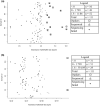Barcoding and traditional health practitioner perspectives are informative to monitor and conserve frogs and reptiles traded for traditional medicine in urban South Africa
- PMID: 37843476
- PMCID: PMC11696476
- DOI: 10.1111/1755-0998.13873
Barcoding and traditional health practitioner perspectives are informative to monitor and conserve frogs and reptiles traded for traditional medicine in urban South Africa
Abstract
Previous literature suggests that Indigenous cultural practices, specifically traditional medicine, are commonplace among urban communities contrary to the general conception that such practices are restricted to rural societies. We reviewed previous literature for records of herptiles (frog and reptile species) sold by traditional health practitioners in urban South Africa, then used visual confirmation surveys, DNA barcoding and folk taxonomy to identify the herptile species that were on sale. Additionally, we interviewed 11 IsiZulu and SePedi speaking traditional health practitioners to document details of the collection and pricing of herptile specimens along with the practitioners' views of current conservation measures for traditional medicine markets. The 34 herptile species recorded in previous literature on traditional medicine markets included endangered and non-native species. Spectrophotometry measurements of the DNA we extracted from the tissue of herptiles used in traditional medicine were an unreliable predictor of whether those extractions would be suitable for further experimental work. From our initial set of 111 tissue samples, 81 sequencing reactions were successful and 55 of those sequences had species-level matches to COI reference sequences on the NCBI GenBank and/or BOLD databases. Molecular identification revealed that traditional health practitioners correctly labelled 77% of the samples that we successfully identified with DNA barcoding in this study. Our mixed methodology approach is useful for conservation planning as it updates knowledge of animal use in Indigenous remedies and can accurately identify species of high conservation priority. Furthermore, this study highlights the possibility of collaborative conservation planning with traditional health practitioners.
Keywords: Ethno‐herpetology; Indigenous knowledge systems; bio‐cultural diversity; mixed‐method analyses; zootherapy.
© 2023 The Authors. Molecular Ecology Resources published by John Wiley & Sons Ltd.
Conflict of interest statement
The authors declare no conflict of interest.
Figures


Similar articles
-
Unexpectedly High Levels of Cryptic Diversity Uncovered by a Complete DNA Barcoding of Reptiles of the Socotra Archipelago.PLoS One. 2016 Mar 1;11(3):e0149985. doi: 10.1371/journal.pone.0149985. eCollection 2016. PLoS One. 2016. PMID: 26930572 Free PMC article.
-
First large-scale DNA barcoding assessment of reptiles in the biodiversity hotspot of Madagascar, based on newly designed COI primers.PLoS One. 2012;7(3):e34506. doi: 10.1371/journal.pone.0034506. Epub 2012 Mar 30. PLoS One. 2012. PMID: 22479636 Free PMC article.
-
DNA barcoding augments conventional methods for identification of medicinal plant species traded at Tanzanian markets.J Ethnopharmacol. 2020 Mar 25;250:112495. doi: 10.1016/j.jep.2019.112495. Epub 2019 Dec 23. J Ethnopharmacol. 2020. PMID: 31877364
-
DNA barcoding and traditional taxonomy: an integrated approach for biodiversity conservation.Genome. 2017 Jul;60(7):618-628. doi: 10.1139/gen-2015-0167. Epub 2017 Apr 21. Genome. 2017. PMID: 28431212 Review.
-
An analysis of the gaps in the South African DNA barcoding library of ticks of veterinary and public health importance.Genome. 2024 Nov 1;67(11):392-402. doi: 10.1139/gen-2024-0052. Epub 2024 Jul 17. Genome. 2024. PMID: 39018572 Review.
References
-
- Alexander, G. (2007). A guide to the reptiles of southern Africa. Penguin Random House.
-
- Alves, R. R. N. , Vieira, W. L. S. , Santana, G. G. , Vieira, K. S. , & Montenegro, P. F. G. P. (2013). Herpetofauna used in indigenous folk medicine: Conservation implications. In Alves R. R. N. & Rosa I. L. (Eds.), Animals in indigenous folk medicine. Springer‐Verlag. 10.1007/978-3-642-29026-8_7 - DOI
-
- Anthony, B. P. , & Bellinger, E. G. (2007). Importance value of landscapes, flora and fauna to Tsonga communities in the rural areas of Limpopo Province, South Africa. South African Journal of Science, 103(3–4), 48–154.
MeSH terms
Grants and funding
LinkOut - more resources
Full Text Sources

